INSTITUT SUPERIEUR D'ANTHROPOLOGIE
INSTITUTE OF ANTHROPOLOGY
ONLINE COURSES / COURS A DISTANCE
SUMMER TERM : JULY 2013
REGISTER NOW
FRANCE –  Vaucelles - Depuis le début du mois de mai et jusqu’à la fin du mois de juin, d’importantes fouilles archéologiques sont en cours à Vaucelles, commune située aux portes de Bayeux. Elles se déroulent en amont d’un aménagement foncier. Six archéologues de l’Institut national de recherches archéologiques préventives (Inrap) ratissent inlassablement les quatre hectares de terrain à des endroits bien stratégiques. « On travaille sur une surface d’environ 1,5 ha », explique Hubert Lepaumier, archéologue. « On a d’abord trouvé la trace d’une occupation néolithique, reprend Hubert Lepaumier. Cela veut dire que dès 5 000 ans avant notre ère, une fréquentation humaine s’est développée sur le site. Ce n’est pas très fréquent. Après, on effectue un bond assez important dans le temps. » Les fouilles ont en effet mené les archéologues vers l’Âge du bronze (2 500 ans avant notre ère). La majeure partie des découvertes repose cependant sur l’Âge du fer, une période qui part du VIIIe siècle avant notre ère jusqu’à la conquête de la Gaule par César en 52 avant Jésus-Christ. Silex taillé (outillage de l’époque néolithique), parures de schiste, fragments de céramique et une petite nécropole (regroupement de plusieurs sépultures) ont notamment été mis au jour dans ce vaste chantier…
Vaucelles - Depuis le début du mois de mai et jusqu’à la fin du mois de juin, d’importantes fouilles archéologiques sont en cours à Vaucelles, commune située aux portes de Bayeux. Elles se déroulent en amont d’un aménagement foncier. Six archéologues de l’Institut national de recherches archéologiques préventives (Inrap) ratissent inlassablement les quatre hectares de terrain à des endroits bien stratégiques. « On travaille sur une surface d’environ 1,5 ha », explique Hubert Lepaumier, archéologue. « On a d’abord trouvé la trace d’une occupation néolithique, reprend Hubert Lepaumier. Cela veut dire que dès 5 000 ans avant notre ère, une fréquentation humaine s’est développée sur le site. Ce n’est pas très fréquent. Après, on effectue un bond assez important dans le temps. » Les fouilles ont en effet mené les archéologues vers l’Âge du bronze (2 500 ans avant notre ère). La majeure partie des découvertes repose cependant sur l’Âge du fer, une période qui part du VIIIe siècle avant notre ère jusqu’à la conquête de la Gaule par César en 52 avant Jésus-Christ. Silex taillé (outillage de l’époque néolithique), parures de schiste, fragments de céramique et une petite nécropole (regroupement de plusieurs sépultures) ont notamment été mis au jour dans ce vaste chantier…
VIDEO = http://www.ouest-france.fr/actu/actuLocale_-Fouilles-archeologiques-pres-de-Bayeux_43200-2203674------14047-aud_actu.Htm
TURQUIE – 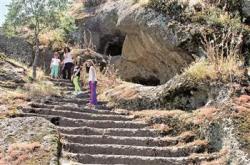 Tekkeköy - The inns where people of the Stone Age lived between 60,000 and 10,000 A.D. in the Black Sea province of Samsun’s Tekkeköy district became popular for archaeologists after being opened to tourism. Not only tourists are interested in the inns; their history has also drawn the attention of archeologists. French archaeologists have applied to the Turkish Ministry of Culture and Arts in order to have an excavation in the area.
Tekkeköy - The inns where people of the Stone Age lived between 60,000 and 10,000 A.D. in the Black Sea province of Samsun’s Tekkeköy district became popular for archaeologists after being opened to tourism. Not only tourists are interested in the inns; their history has also drawn the attention of archeologists. French archaeologists have applied to the Turkish Ministry of Culture and Arts in order to have an excavation in the area.
http://www.hurriyetdailynews.com/french-archaeologists-to-examine-stone-age-inns-in-black-sea-province.aspx?pageID=238&nID=48956&NewsCatID=375
USA - Alkali Ridge - Traces of the oldest known chocolate in the United States have been recovered from an ancient settlement in southeastern Utah, according to an anthropologist whose report was recently published in the Journal of Archaeological Science. Dating back to the 8th century, the settlement, known as Alkali Ridge, belonged to the Ancestral Puebloans. The traces of chocolate were found inside jars, pitchers, and bowls at the site, according to Dr. Dorothy Washburn, a researcher at the University of Pennsylvania's Museum of Archaeology and Anthropology. Specifically, Washburn found a chemical called theobromine, which much like caffeine is a compound that is found in abundance in cacao. "The only conclusion can be that it’s cacao," Washburn said. Considering the cacao tree is a tropical plant that is found thousands of miles from Utah and in areas dominated by Mesoamerican Indian tribes, and not Puebloans, it is not clear how it arrived in the region, notes Western Digs website. Though it is unclear how the cacao traveled so far North, the conventional theory is that cacao was a sought-after commodity that made its way North along trade routes. Cacao was valued among ancient Native American tribes as a natural stimulant, while chocolate was an important food and ceremonial drink.
http://www.newsmax.com/thewire/earliest-chocolate-discovered/2013/06/17/id/510346
ETHIOPIE – 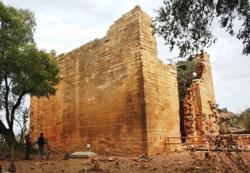 Yeha - The Great Yeha Temple built around 8th century B.C. is to be renovated in cooperation of Authority for Research and Conservation of Cultural Heritage of Ethiopia, Tigray Culture and Tourism Agency and German Archaeology Institute. The Temple is close to 3000 years-old, the longest in Sub-Saharan Africa for a building. In a statement German Archaeology Institute issued in connection with the renovation, it said the Temple would be made to be preserved for the next generation as it is. Authority for Research and Conservation of Cultural Heritage for its part said it would assess the renovation proposal by experts and would go operational soon. Yeha is a large Bronze Age archaeological site located about 25 km northeast of the modern town of Adwa, in Ethiopia.
Yeha - The Great Yeha Temple built around 8th century B.C. is to be renovated in cooperation of Authority for Research and Conservation of Cultural Heritage of Ethiopia, Tigray Culture and Tourism Agency and German Archaeology Institute. The Temple is close to 3000 years-old, the longest in Sub-Saharan Africa for a building. In a statement German Archaeology Institute issued in connection with the renovation, it said the Temple would be made to be preserved for the next generation as it is. Authority for Research and Conservation of Cultural Heritage for its part said it would assess the renovation proposal by experts and would go operational soon. Yeha is a large Bronze Age archaeological site located about 25 km northeast of the modern town of Adwa, in Ethiopia.
http://www.ethiosports.com/2013/06/17/the-great-yeha-temple-to-be-renovated/#sthash.2KmBrofx.dpbs
ROYAUME UNI – 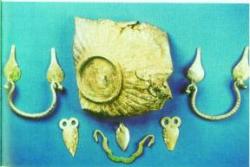 Swindon - It is one of the most important artefacts ever unearthed in Swindon and now experts are hoping to unravel the secrets they believe are contained within a buckled 1,600 year-old ceremonial silver bowl. Plans are also underway to recreate a lustrous replica of the precious Roman vessel as it looked when it was crafted to be displayed alongside the crushed original at Swindon Museum. The 38-ribbed fluted liturgical banquet bowl, painstakingly fashioned from high quality silver and boasting swan-neck beaded handles, would have been used in religious ceremonies during the British Romano period. It is believed the bowl was deliberately crushed before being buried during the 4th century AD – a time of immense upheaval when the Romans left Britain to fend for itself against invading hordes. Mr Walters said: “This is an extraordinary artefact. I believe the bowl was folded like an envelope to conceal something inside. We know there is a sheet of metal, or possibly silver inside. It is really important for us to see whatever it is.
Swindon - It is one of the most important artefacts ever unearthed in Swindon and now experts are hoping to unravel the secrets they believe are contained within a buckled 1,600 year-old ceremonial silver bowl. Plans are also underway to recreate a lustrous replica of the precious Roman vessel as it looked when it was crafted to be displayed alongside the crushed original at Swindon Museum. The 38-ribbed fluted liturgical banquet bowl, painstakingly fashioned from high quality silver and boasting swan-neck beaded handles, would have been used in religious ceremonies during the British Romano period. It is believed the bowl was deliberately crushed before being buried during the 4th century AD – a time of immense upheaval when the Romans left Britain to fend for itself against invading hordes. Mr Walters said: “This is an extraordinary artefact. I believe the bowl was folded like an envelope to conceal something inside. We know there is a sheet of metal, or possibly silver inside. It is really important for us to see whatever it is.
http://www.swindonadvertiser.co.uk/news/10489856.Hidden_secret_of_the_silver_bowl/
GRECE – 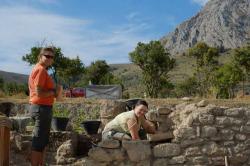 Corinthe - Excavations in Ancient Corinth by the American School of Classical Studies at Athens officially came to a close Friday June 14. Aim of the 2013 season was to clarify the Late Roman levels beneath Byzantine and Frankish structures in the area south of the South Stoa. South of the South Stoa, students excavated in Byzantine and Late Roman levels, encountering the first glimpses of stratified Hellenistic and Classical. This year’s energetic group in the field included Kate Larson, Jon Meyer, Grace Erny, Emily Joy, Alison Fields, Jessica Lamont, Hilary Lehmann, Kyle Jazwa, Mohammed Ali Bhatti, Dan Diffendale, Katherine Harrington and Jana Mokrisova. Rossana Valente was the field director with the initial help of Heather Graybehl in the first session. Kate Larson assisted in the museum identifying coins and glass. Audrey Blumstein is volunteering in the museum, organizing pottery deposits from the Potters’ Quarter, identifying and cataloging excavation coins, and transcribing Swift’s notebook. Larkin Kennedy is continuing her work with the human bone collection while cataloguing Asklepieion votives and connecting them context descriptions. Larkin is also transcribing De Waele’s excavation notebooks from the Asklepieion.
Corinthe - Excavations in Ancient Corinth by the American School of Classical Studies at Athens officially came to a close Friday June 14. Aim of the 2013 season was to clarify the Late Roman levels beneath Byzantine and Frankish structures in the area south of the South Stoa. South of the South Stoa, students excavated in Byzantine and Late Roman levels, encountering the first glimpses of stratified Hellenistic and Classical. This year’s energetic group in the field included Kate Larson, Jon Meyer, Grace Erny, Emily Joy, Alison Fields, Jessica Lamont, Hilary Lehmann, Kyle Jazwa, Mohammed Ali Bhatti, Dan Diffendale, Katherine Harrington and Jana Mokrisova. Rossana Valente was the field director with the initial help of Heather Graybehl in the first session. Kate Larson assisted in the museum identifying coins and glass. Audrey Blumstein is volunteering in the museum, organizing pottery deposits from the Potters’ Quarter, identifying and cataloging excavation coins, and transcribing Swift’s notebook. Larkin Kennedy is continuing her work with the human bone collection while cataloguing Asklepieion votives and connecting them context descriptions. Larkin is also transcribing De Waele’s excavation notebooks from the Asklepieion.
http://www.archaiologia.gr/en/blog/2013/06/18/excavations-in-ancient-corinth/
USA – 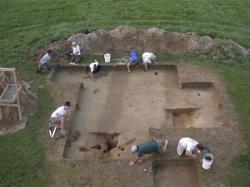 Werowocomoco - A farm field overlooking the York River in Tidewater Virginia is believed to be where Pocahontas interceded with her powerful father Powhatan to rescue English Capt. John Smith from death. That's a fanciful footnote for many Virginia Indians, historians and archaeologists, who say the real story is that this land was the center of a complex, sprawling empire ruled by Powhatan long before the first permanent English settlement in American was founded in 1607. It was called Werowocomoco, which roughly translates to a "place of chiefs." Only a fraction of Werewocomoco has been explored, perhaps just 2 percent. After decades of research, archaeologists used the writings of Smith and others, ancient maps and detective work to conclude with near-certainty that this was Powhatan's seat of power about 15 miles from Jamestown. Powhatan's chiefdom covered 30 political divisions and a population of 15,000 to 20,000 people while Jamestown settlers struggled to survive. Excavations have yielded the outline of the largest longhouse ever found in Virginia and a system of ditches that may have separated sacred and secular areas.
Werowocomoco - A farm field overlooking the York River in Tidewater Virginia is believed to be where Pocahontas interceded with her powerful father Powhatan to rescue English Capt. John Smith from death. That's a fanciful footnote for many Virginia Indians, historians and archaeologists, who say the real story is that this land was the center of a complex, sprawling empire ruled by Powhatan long before the first permanent English settlement in American was founded in 1607. It was called Werowocomoco, which roughly translates to a "place of chiefs." Only a fraction of Werewocomoco has been explored, perhaps just 2 percent. After decades of research, archaeologists used the writings of Smith and others, ancient maps and detective work to conclude with near-certainty that this was Powhatan's seat of power about 15 miles from Jamestown. Powhatan's chiefdom covered 30 political divisions and a population of 15,000 to 20,000 people while Jamestown settlers struggled to survive. Excavations have yielded the outline of the largest longhouse ever found in Virginia and a system of ditches that may have separated sacred and secular areas.
http://www.star-telegram.com/2013/06/18/4945895/va-site-of-pocahontas-rescue-will.html